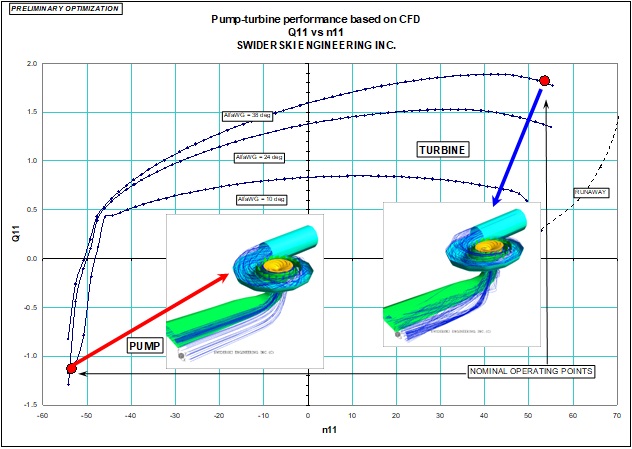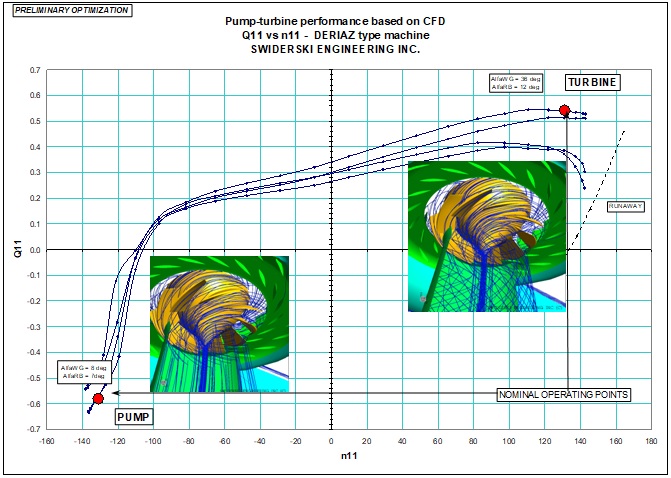Reversible machines
Recently, SEi has developed the new M-ODOMrev process – an extension of M-ODOM – by implementing parallel optimization to design reversible machines (pump-turbines). The most challenging aspect of the design of a reversible machine is the need to run two optimization algorithms in tandem: one for the turbine mode and one for the pump mode. This demands careful, weighted decisions at each iteration of the optimization process to ensure that the machine functions efficiently in both modes. This new process has been tested and implemented for both Francis and Deriaz type turbines.
 Three quadrant performances results of the CFD analysis – Francis-type runner
Three quadrant performances results of the CFD analysis – Francis-type runner
 Three quadrant performances results of the CFD analysis – Deriaz-type runner
Three quadrant performances results of the CFD analysis – Deriaz-type runner
M-ODOM enhancements
The latest developments in the M-ODOM process deal with an implementation of weighting coefficients to each operating point as well as an implementation of the accelerating procedure for the four-operating-point optimization. Since so defined targets of optimization seem to be the most common in the industry, SEi has been working on enhancing the intermediate decision-making process that accelerates the general optimization process. Depending on the given weighting points, the process conducts verification of performances at each point separately. Single point optimization (i.e., maximizing efficiency at the peak) becomes a specific case of this algorithm.

The combined design target for the Weighted Efficiency criteria
Combined design target defined as:

Composite Materials Applications
The use of composite materials in the hydropower industry remains a relatively unexplored area. The ever-decreasing price of composite materials and the expanding availability of affordable rapid prototyping methods (3D Printing) for the purpose of tool production offers new possibilities in turbine runner manufacturing. SEi has been researching this area for the past several years, specifically focusing on the manufacture of runner blades.
Manufacturing turbine runner blades using composite materials offers several benefits. First, it allows complete freedom to choose the shape of the blades. Blade designs that would be difficult or impossible to produce using traditional methods such as casting, machining, or welding can be produced with relative ease using composite materials in conjunction with 3D printing. This entails fewer restraints on the shape of designs and makes it possible to increase turbine performance.
Second, a wide variety of composite materials can be selected to suit the blade’s design criteria. For example, runner blades containing thin sections subjected to high loads can be manufactured from materials offering excellent strength and stiffness, like carbon fibre laminate, while the low head turbines blades that do not experience high stresses can be made from inexpensive forged fibreglass.
So far, SEi has successfully used 3D printing and composite materials to create several prototypes of turbine blades for runners of diameters of 360mm and below. We are currently in the process of arranging laboratory testing for the prototypes. If successful, runners like these could provide an inexpensive alternative for use in laboratory model testing of larger units and in small and low head hydroelectric plants.
 A carbon fibre and fibreglass combined with 3D printed components – double-regulated prototype model assembly with a Kaplan-type runner.
A carbon fibre and fibreglass combined with 3D printed components – double-regulated prototype model assembly with a Kaplan-type runner.
|


















